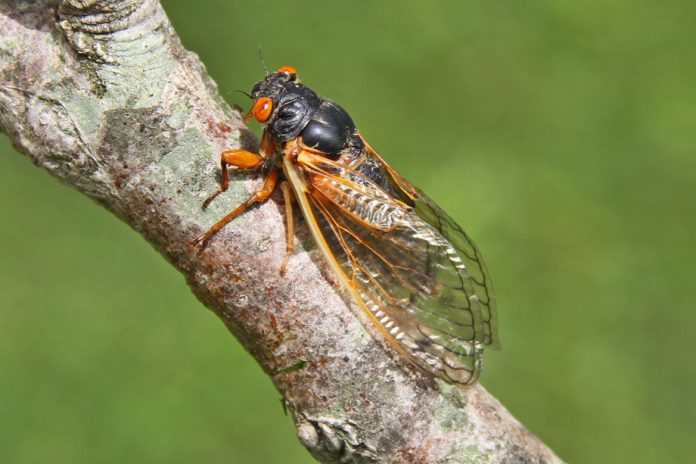
Q: I’ve heard that cicadas can be eaten. Is that true?
A: Yes, it is true. Cicadas are among those insects that are safe to eat. And if you are among those who want to give them a try, this is the summer to do it.
The periodical cicada known as Brood X will arrive in the millions in the Midwest over the next few weeks, as the temperatures warm. Brood X is one of 12 periodical cicadas that emerge every 17 years, from mid-May to late June. Another three broods emerge every 13 years, primarily in southern states.
Brood X includes three species — Magicicada septendecim, Magicicada cassini and Magicicada septendecula — each of which will come up at different times during the spring, says David Shetlar, a professor emeritus of entomology with Ohio State University Extension.
The Brood X female cicadas lay hundreds of eggs in tree branches. After hatching, the nymphs fall to the soil and burrow underground, feeding on tree roots. Some 13 or 17 years later when it’s time, the nymphs emerge from the soil, shed their skin, expand their wings and harden and pigment their new exoskeleton.
The males then sing to attract females, mate, and the females lay their eggs, starting the process over again, Shetlar said. For those of you who are on the more adventurous side of things, these cicadas can be a tasty treat, he said.
“These things are perfectly edible,” Shetlar said, noting that they “have the consistency of milk chocolate with a mild, nutty flavor, like roasted almonds.”
Preparation
Shetlar said he’s seen people eat cicadas on top of cookies, and fry them and dip them in chocolate. He said for those who are wanting to try this delicacy, its best to get the nymphs as they emerge, typically best done about an hour or two after dark, which is their peak emergence time. They should be washed thoroughly and then frozen until ready to prepare.
“When ready to cook, quickly rinse them in water to thaw, then blot dry with a paper towel, snipping the legs off or leaving them on if you want,” Shetlar said. “Simply fry them in a pan with some butter, or toss in a little bacon or bacon fat for added flavor. Once they have been fried, they can be put into some pasta, rice or put on a bed of greens. They will be just a little different than small popcorn shrimp.”
Shetlar said the teneral adults — those that have emerged from their nymphal skin — are white and haven’t expanded their wings. They’re soft and equivalent to soft-shell crab. They can also be fried or dipped in shrimp-like batter and then fried.
Precautions
However, before you decide to indulge in your favorite cicada recipe, Shetlar said, it’s important to cook any insect collected in the wild and avoid eating it raw.
“While there is little risk of any dangerous pathogens or parasites to be found in cicadas, there is always the slim risk of picking up something that you certainly don’t want to get by eating the cicadas raw,” he said.
Another precaution: If you have any shellfish allergies, you should avoid eating cicadas, the U.S. Food and Drug Administration warned recently on Twitter.
“Don’t eat #cicadas if you’re allergic to seafood as these insects share a family relation to shrimp and lobsters,” the FDA wrote in the tweet.
Other insects
Cicadas aren’t the only insects that are edible, says Ellen Klinger, a CFAES assistant professor of entomology. Cultures around the world routinely consume insects as part of their daily fare.
“Emperor moth caterpillars, commonly called mopane worms, are a popular snack in South African countries,” she said. “Chapulines, roasted and seasoned grasshoppers, fill tacos in Mexico. In China, silkworm moth pupae are canned and found on store shelves, providing a high-protein and high-fat food source that was also considered for use as a food source by astronauts.”
In many cases, insect foods provide higher protein and less fat than conventional meat sources, while requiring lower environmental inputs such as water and land, Klinger said.
“The lack of intentional insect consumption in the United States and other developed countries is actually quite unique,” she said. “Entomophagy — eating insects — is a cultural practice that has been lost in most of these countries.”
(Chow Line is a service of the Ohio State University College of Food, Agricultural, and Environmental Sciences and its outreach and research arms, Ohio State University Extension and the Ohio Agricultural Research and Development Center. Send questions to Chow Line writer Tracy Turner, 364 W. Lane Ave., Suite B120, Columbus, OH 43201, or turner.490@osu.edu.)












